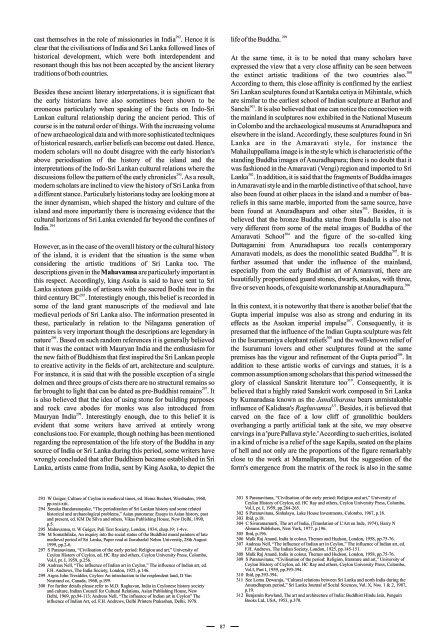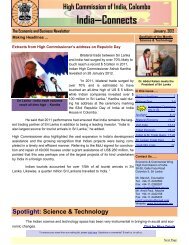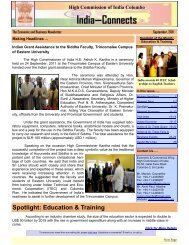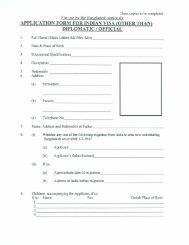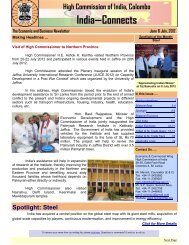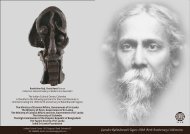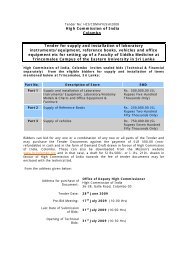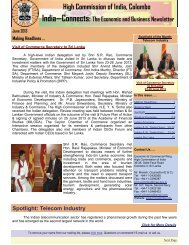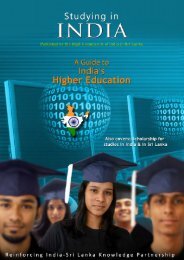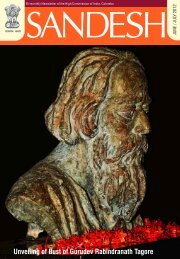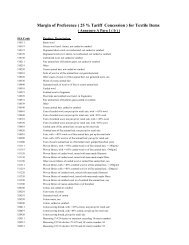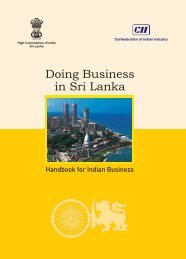Papers presented at the International Buddhist Conference, March ...
Papers presented at the International Buddhist Conference, March ...
Papers presented at the International Buddhist Conference, March ...
You also want an ePaper? Increase the reach of your titles
YUMPU automatically turns print PDFs into web optimized ePapers that Google loves.
292<br />
cast <strong>the</strong>mselves in <strong>the</strong> role of missionaries in India . Hence it is<br />
clear th<strong>at</strong> <strong>the</strong> civilis<strong>at</strong>ions of India and Sri Lanka followed lines of<br />
historical development, which were both interdependent and<br />
resonant though this has not been accepted by <strong>the</strong> ancient literary<br />
traditions of both countries.<br />
Besides <strong>the</strong>se ancient literary interpret<strong>at</strong>ions, it is significant th<strong>at</strong><br />
<strong>the</strong> early historians have also sometimes been shown to be<br />
erroneous particularly when speaking of <strong>the</strong> facts on Indo-Sri<br />
Lankan cultural rel<strong>at</strong>ionship during <strong>the</strong> ancient period. This of<br />
course is in <strong>the</strong> n<strong>at</strong>ural order of things. With <strong>the</strong> increasing volume<br />
of new archaeological d<strong>at</strong>a and with more sophistic<strong>at</strong>ed techniques<br />
of historical research, earlier beliefs can become out d<strong>at</strong>ed. Hence,<br />
modern scholars will no doubt disagree with <strong>the</strong> early historian's<br />
above periodis<strong>at</strong>ion of <strong>the</strong> history of <strong>the</strong> island and <strong>the</strong><br />
interpret<strong>at</strong>ions of <strong>the</strong> Indo-Sri Lankan cultural rel<strong>at</strong>ions where <strong>the</strong><br />
293<br />
discussions follow <strong>the</strong> p<strong>at</strong>tern of <strong>the</strong> early chronicles . As a result,<br />
modern scholars are inclined to view <strong>the</strong> history of Sri Lanka from<br />
a different stance. Particularly historians today are looking more <strong>at</strong><br />
<strong>the</strong> inner dynamism, which shaped <strong>the</strong> history and culture of <strong>the</strong><br />
island and more importantly <strong>the</strong>re is increasing evidence th<strong>at</strong> <strong>the</strong><br />
cultural horizons of Sri Lanka extended far beyond <strong>the</strong> confines of<br />
294<br />
India.<br />
However, as in <strong>the</strong> case of <strong>the</strong> overall history or <strong>the</strong> cultural history<br />
of <strong>the</strong> island, it is evident th<strong>at</strong> <strong>the</strong> situ<strong>at</strong>ion is <strong>the</strong> same when<br />
considering <strong>the</strong> artistic traditions of Sri Lanka too. The<br />
descriptions given in <strong>the</strong> Mahavamsa are particularly important in<br />
this respect. Accordingly, king Asoka is said to have sent to Sri<br />
Lanka sixteen guilds of artisans with <strong>the</strong> sacred Bodhi tree in <strong>the</strong><br />
295<br />
third century BC . Interestingly enough, this belief is recorded in<br />
some of <strong>the</strong> land grant manuscripts of <strong>the</strong> medieval and l<strong>at</strong>e<br />
medieval periods of Sri Lanka also. The inform<strong>at</strong>ion <strong>presented</strong> in<br />
<strong>the</strong>se, particularly in rel<strong>at</strong>ion to <strong>the</strong> Nilagama gener<strong>at</strong>ion of<br />
painters is very important though <strong>the</strong> descriptions are legendary in<br />
296<br />
n<strong>at</strong>ure . Based on such random references it is generally believed<br />
th<strong>at</strong> it was <strong>the</strong> contact with Mauryan India and <strong>the</strong> enthusiasm for<br />
<strong>the</strong> new faith of Buddhism th<strong>at</strong> first inspired <strong>the</strong> Sri Lankan people<br />
to cre<strong>at</strong>ive activity in <strong>the</strong> fields of art, architecture and sculpture.<br />
For instance, it is said th<strong>at</strong> with <strong>the</strong> possible exception of a single<br />
dolmen and three groups of cists <strong>the</strong>re are no structural remains so<br />
297<br />
far brought to light th<strong>at</strong> can be d<strong>at</strong>ed as pre-<strong>Buddhist</strong> remains . It<br />
is also believed th<strong>at</strong> <strong>the</strong> idea of using stone for building purposes<br />
and rock cave abodes for monks was also introduced from<br />
298<br />
Mauryan India . Interestingly enough, due to this belief it is<br />
evident th<strong>at</strong> some writers have arrived <strong>at</strong> entirely wrong<br />
conclusions too. For example, though nothing has been mentioned<br />
regarding <strong>the</strong> represent<strong>at</strong>ion of <strong>the</strong> life story of <strong>the</strong> Buddha in any<br />
source of India or Sri Lanka during this period, some writers have<br />
wrongly concluded th<strong>at</strong> after Buddhism became established in Sri<br />
Lanka, artists came from India, sent by King Asoka, to depict <strong>the</strong><br />
299<br />
life of <strong>the</strong> Buddha.<br />
At <strong>the</strong> same time, it is to be noted th<strong>at</strong> many scholars have<br />
expressed <strong>the</strong> view th<strong>at</strong> a very close affinity can be seen between<br />
300<br />
<strong>the</strong> extinct artistic traditions of <strong>the</strong> two countries also.<br />
According to <strong>the</strong>m, this close affinity is confirmed by <strong>the</strong> earliest<br />
Sri Lankan sculptures found <strong>at</strong> Kantaka cetiya in Mihintale, which<br />
are similar to <strong>the</strong> earliest school of Indian sculpture <strong>at</strong> Barhut and<br />
301<br />
Sanchi . It is also believed th<strong>at</strong> one can notice <strong>the</strong> connection with<br />
<strong>the</strong> mainland in sculptures now exhibited in <strong>the</strong> N<strong>at</strong>ional Museum<br />
in Colombo and <strong>the</strong> archaeological museums <strong>at</strong> Anuradhapura and<br />
elsewhere in <strong>the</strong> island. Accordingly, <strong>the</strong>se sculptures found in Sri<br />
Lanka are in <strong>the</strong> Amarav<strong>at</strong>i style, for instance <strong>the</strong><br />
Mahailuppallama image is in <strong>the</strong> style which is characteristic of <strong>the</strong><br />
standing Buddha images of Anuradhapura; <strong>the</strong>re is no doubt th<strong>at</strong> it<br />
was fashioned in <strong>the</strong> Amarav<strong>at</strong>i (Vengi) region and imported to Sri<br />
302<br />
Lanka . In addition, it is said th<strong>at</strong> <strong>the</strong> fragments of Buddha images<br />
in Amarav<strong>at</strong>i style and in <strong>the</strong> marble distinctive of th<strong>at</strong> school, have<br />
also been found <strong>at</strong> o<strong>the</strong>r places in <strong>the</strong> island and a number of basreliefs<br />
in this same marble, imported from <strong>the</strong> same source, have<br />
303<br />
been found <strong>at</strong> Anuradhapura and o<strong>the</strong>r sites . Besides, it is<br />
believed th<strong>at</strong> <strong>the</strong> bronze Buddha st<strong>at</strong>ue from Badulla is also not<br />
very different from some of <strong>the</strong> metal images of Buddha of <strong>the</strong><br />
304<br />
Amarav<strong>at</strong>i School and <strong>the</strong> figure of <strong>the</strong> so-called king<br />
Duttagamini from Anuradhapura too recalls contemporary<br />
305<br />
Amarav<strong>at</strong>i models, as does <strong>the</strong> monolithic se<strong>at</strong>ed Buddha . It is<br />
fur<strong>the</strong>r assumed th<strong>at</strong> under <strong>the</strong> influence of <strong>the</strong> mainland,<br />
especially from <strong>the</strong> early <strong>Buddhist</strong> art of Amarav<strong>at</strong>i, <strong>the</strong>re are<br />
beautifully proportioned guard stones, dwarfs, snakes, with three,<br />
306<br />
five or seven hoods, of exquisite workmanship <strong>at</strong> Anuradhapura.<br />
In this context, it is noteworthy th<strong>at</strong> <strong>the</strong>re is ano<strong>the</strong>r belief th<strong>at</strong> <strong>the</strong><br />
Gupta imperial impulse was also as strong and enduring in its<br />
307<br />
effects as <strong>the</strong> Asokan imperial impulse . Consequently, it is<br />
presumed th<strong>at</strong> <strong>the</strong> influence of <strong>the</strong> Indian Gupta sculpture was felt<br />
308<br />
in <strong>the</strong> Isurumuniya elephant reliefs and <strong>the</strong> well-known relief of<br />
<strong>the</strong> Isurumuni lovers and o<strong>the</strong>r sculptures found <strong>at</strong> <strong>the</strong> same<br />
209<br />
premises has <strong>the</strong> vigour and refinement of <strong>the</strong> Gupta period . In<br />
addition to <strong>the</strong>se artistic works of carvings and st<strong>at</strong>ues, it is a<br />
common assumption among scholars th<strong>at</strong> this period witnessed <strong>the</strong><br />
310<br />
glory of classical Sanskrit liter<strong>at</strong>ure too . Consequently, it is<br />
believed th<strong>at</strong> a highly r<strong>at</strong>ed Sanskrit work composed in Sri Lanka<br />
by Kumaradasa known as <strong>the</strong> Janakiharana bears unmistakable<br />
311<br />
influence of Kalidasa's Raghuvamsa . Besides, it is believed th<strong>at</strong><br />
carved on <strong>the</strong> face of a low cliff of granolithic boulders<br />
overhanging a partly artificial tank <strong>at</strong> <strong>the</strong> site, we may observe<br />
carvings in a 'pure Pallava style.' According to such critics, isol<strong>at</strong>ed<br />
in a kind of niche is a relief of <strong>the</strong> sage Kapila, se<strong>at</strong>ed on <strong>the</strong> plains<br />
of hell and not only are <strong>the</strong> proportions of <strong>the</strong> figure remarkably<br />
close to <strong>the</strong> work <strong>at</strong> Mamallapuram, but <strong>the</strong> suggestion of <strong>the</strong><br />
form's emergence from <strong>the</strong> m<strong>at</strong>rix of <strong>the</strong> rock is also in <strong>the</strong> same<br />
293 W Geiger, Culture of Ceylon in medieval times, ed. Heinz Bechert, Wiesbaden, 1960,<br />
pp.xxii-xiii.<br />
294 Senaka Bandaranayake, “The periodis<strong>at</strong>ion of Sri Lankan history and some rel<strong>at</strong>ed<br />
historical and archaeological problems,” Asian panorama: Essays in Asian history, past<br />
and present, ed. KM De Silva and o<strong>the</strong>rs, Vikas Publishing House, New Delhi, 1990,<br />
p.5.<br />
295 Mahavamsa, tr. W Geiger, Pali Text Society, London, 1934, chap.19; 1-4vv.<br />
296 M Som<strong>at</strong>hilake, An inquiry into <strong>the</strong> social st<strong>at</strong>us of <strong>the</strong> <strong>Buddhist</strong> mural painters of l<strong>at</strong>e<br />
medieval period of Sri Lanka, Paper read <strong>at</strong> Jawaharlal Nehru University, 28th August<br />
1999, pp.2-6.<br />
297 S Paranavitana, “Civilis<strong>at</strong>ion of <strong>the</strong> early period: Religion and art,” University of<br />
Ceylon History of Ceylon, ed. HC Ray and o<strong>the</strong>rs, Ceylon University Press, Colombo,<br />
Vol.I, pt. I, 1959, p.256.<br />
298 Andreas Nell, “The influence of Indian art in Ceylon,” The influence of Indian art, ed.<br />
F.H. Andrews, The India Society, London, 1925, p.146.<br />
299 Argns John Tresidder, Ceylon: An introduction to <strong>the</strong> resplendent land, D Van<br />
Nostrand co, Canada, 1960, p.199.<br />
300 For fur<strong>the</strong>r details please refer to M.D. Raghavan, India in Ceylonese history society<br />
and culture, Indian Council for Cultural Rel<strong>at</strong>ions, Asian Publishing House, New<br />
Delhi, 1969, pp.94-113; Andreas Nell, “The influence of Indian art in Ceylon” The<br />
influence of Indian Art, ed. F.H. Andrews, Delhi Printers Prakashan, Delhi, 1978.<br />
301 S Paranavitana, “Civilis<strong>at</strong>ion of <strong>the</strong> early period: Religion and art,” University of<br />
Ceylon History of Ceylon, ed. HC Ray and o<strong>the</strong>rs, Ceylon University Press, Colombo,<br />
Vol.I, pt. I, 1959, pp.264-265.<br />
302 S Paranavitana, Sinhalayo, Lake House Investments, Colombo, 1967, p.18.<br />
303 Ibid, p.18.<br />
304 C Sivaramamurti, The art of India, (Transl<strong>at</strong>ion of L’Art en Inde, 1974), Harry N<br />
Abrams Publishers, New York, 1977, p.196.<br />
305 Ibid, p.196.<br />
306 Mulk Raj Anand, India in colour, Themes and Hudson, London, 1958, pp.75-76.<br />
307 Andreas Nell, “The influence of Indian art in Ceylon,” The influence of Indian art, ed.<br />
F.H. Andrews, The Indian Society, London, 1925, pp.145-151.<br />
308 Mulk Raj Anand, India in colour, Themes and Hudson, London, 1958, pp.75-76.<br />
309 S Paranavitana, “Civilis<strong>at</strong>ion of <strong>the</strong> period: Religion, liter<strong>at</strong>ure and art,” University of<br />
Ceylon History of Ceylon, ed. HC Ray and o<strong>the</strong>rs, Ceylon University Press, Colombo,<br />
Vol.I, Part I, 1959, pp.393-394.<br />
310 Ibid, pp.393-394.<br />
311 See Lorna Dewaraja, “Cultural rel<strong>at</strong>ions between Sri Lanka and north India during <strong>the</strong><br />
Anuradhapura period,” Sri Lanka Journal of Social Sciences, Vol. X, Nos. 1 & 2, 1987,<br />
p.19.<br />
312 Benjamin Rowland, The art and architecture of India: <strong>Buddhist</strong> Hindu Jain, Penguin<br />
Books Ltd, USA, 1953, p.370.<br />
87


